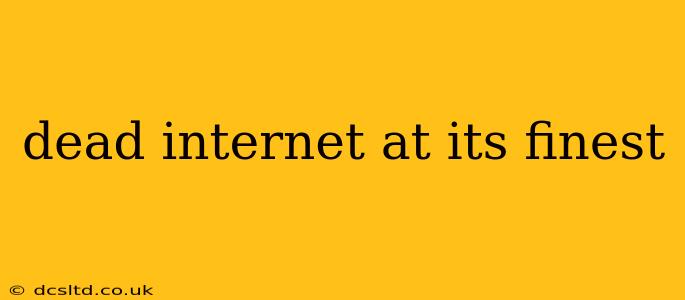The internet, a boundless realm of information and connection, has undergone a fascinating evolution. While the constant influx of new platforms and trends captivates us, a nostalgic wave has risen, celebrating the quirks and charm of the "dead internet"—a term encompassing the online world of the late 90s and early 2000s. This era, characterized by dial-up connections, Geocities websites, and early social media platforms, holds a unique appeal for many, and exploring its intricacies reveals much about the internet's history and our evolving relationship with technology.
What Exactly is the "Dead Internet?"
The "dead internet" isn't literally dead; it's a nostalgic term referencing a specific period in internet history. It represents a time before the sleek, polished interfaces and algorithms of today's web. Think vibrant, often poorly designed websites, flashing GIFs, clunky animations, and a strong sense of individual expression unfiltered by corporate curation. It was a wilder, more experimental, and undeniably more chaotic space, characterized by:
- Geocities and Angelfire: These free website hosting services allowed individuals to create personal pages brimming with personality, often featuring bizarre aesthetics and unconventional layouts.
- Dial-up Connections: The infamous screech of the modem, slow loading speeds, and the constant fear of being disconnected were all part of the experience.
- Early Social Networks: Remember Friendster, MySpace, and early forums? These platforms provided a sense of community unlike anything seen today.
- BBS (Bulletin Board Systems): Precursors to online forums, these were text-based communication hubs where users could connect and share information.
Why Do People Miss the "Dead Internet"?
The appeal of the "dead internet" is multifaceted. Many find it endearing for its:
- Authenticity and Individuality: Websites weren't polished and optimized for search engines. Instead, they reflected the unique personalities and interests of their creators.
- Sense of Community: Early online platforms fostered a strong sense of belonging and shared experience.
- Creative Freedom: The limitations of the technology actually fueled creativity. Users had to be resourceful and innovative.
- Nostalgia: For many, it evokes a sense of simpler times, a time before the pressures of social media and constant online connectivity.
How Does the "Dead Internet" Compare to Today's Internet?
The contrast between the "dead internet" and today's internet is stark. Today's internet is characterized by:
- Highly curated content: Algorithms dictate what we see, limiting exposure to diverse perspectives.
- Emphasis on aesthetics and design: Websites prioritize polished visuals over individual expression.
- Faster speeds and seamless connectivity: The technology is far more advanced, but the immediacy and constant accessibility can be overwhelming.
- Increased commercialization: Advertising and monetization strategies are far more prevalent.
What are Some Examples of "Dead Internet" Aesthetics?
The visual elements of the "dead internet" are instantly recognizable:
- Sparkly GIFs: Animated images were a staple, often excessively used.
- Underlined text: This was a common way to emphasize words, even if it wasn't a link.
- Countless flashing banners: These were ubiquitous, and many found them intrusive.
- Crazy color schemes: Websites often featured jarring color combinations that would be considered poor design today.
- Comic Sans and Papyrus fonts: These fonts were wildly popular, despite their often-criticized aesthetic.
Was the "Dead Internet" Better Than Today's Internet?
This is a subjective question. While the "dead internet" had its charms, it also had significant drawbacks, including:
- Slow speeds: Dial-up connections severely limited functionality.
- Limited accessibility: Many parts of the world lacked internet access.
- Security risks: The lack of robust security measures made online activities riskier.
- Lack of organization and information overload: Finding relevant information could be challenging.
The "dead internet" offers a fascinating glimpse into the history of the web. While it might not be practical to return to its quirks, appreciating its unique character provides valuable perspective on our evolving relationship with online spaces. The nostalgia surrounding it highlights our longing for simpler times, a stronger sense of community, and the unfiltered creativity of an era before algorithms and curated content dominated the digital landscape.
